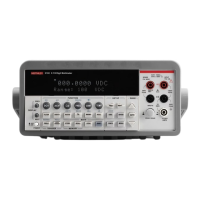:REFerence <n> commands
:REFerence <n>
[:SENSe[1]]:CURRent:AC:REFerence <n> Specify reference for ACI
[:SENSe[1]]:CURRent[:DC]:REFerence <n> Specify reference for DCI
[:SENSe[1]]:VOLTage:AC:REFerence <n> Specify reference for ACV
:SENSe[1]]:VOLTage[:DC]:REFerence <n> Specify reference for DCV
[:SENSe[1]]:RESistance:REFerence <n> Specify reference for Ω2
[:SENSe[1]]:FRESistance:REFerence <n> Specify reference for Ω4
[:SENSe[1]]:FREQuency:REFerence <n> Specify reference for FREQ
[:SENSe[1]]:PERiod:REFerence <n> Specify reference for PER
[:SENSe[1]]:TEMPerature:REFerence <n> Specify reference for TEMP
Parameters <n> = -3.1 to 3.1 Reference for ACI and DCI
-757.5 to 757.5 Reference for ACV
-1010 to 1010 Reference for DCV
0 to 120e6 Reference for
Ω2 and Ω4
0 to 1.5e7 Reference for FREQ
0 to 1 Reference for PER
-200 to 1372 Reference for TEMP
DEFault 0 (all functions)
MINimum Minimum value for specified function
MAXimum Maximum value for specified function
Query :REFerence? Query programmed reference value
:REFerence? DEFault Query *RST default reference value
:REFerence? MINimum Query lowest allowable reference value
:REFerence? MAXimum Query largest allowable reference value
Description These commands are used to establish a reference value for the specified
function. When Reference is enabled (see :REFerence:STATe), the result
will be the algebraic difference between the input signal and the reference
value:
Reading = Input signal - Reference
From the front panel, reference is called relative (REL).
The :REFerence <n> command is coupled to the :ACQuire command. The
last command sent (:REFerence <n> or :ACQuire) establishes the reference.
When a reference is set using the :REFerence <n> command, the :REFer-
ence? query command returns the programmed value. Conversely, when a
reference is set using the :ACQuire command, the :REFerence? query com-
mand returns the acquired reference value.
SCPI Command Reference 5-43

